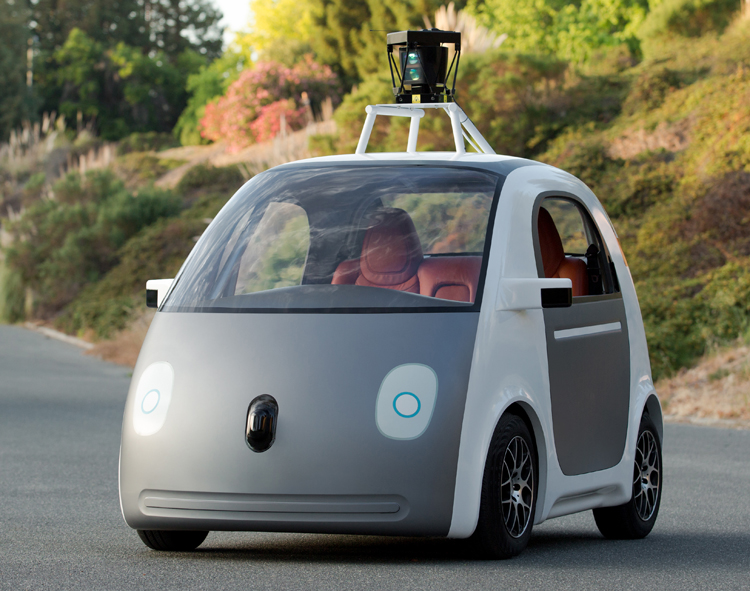The race for building the world’s first commercially available driverless car is on. Google seems to be leading the pack and in its own charismatic style has been very open about it. Elon Musk’s Tesla is considered the second best with their cars having almost automated the driving process. Tech favourites, Apple also seem to be in the race but everything is under wraps, as of now, and there is not even a hint of what Apple is planning to make, the car, the software or simply make the car accessible with your Apple ID.
 |
| KITT, from Knight Rider, was probably the best known autonomous car |
While this sounds like a great plan, it requires that cars approaching an intersection can talk to each other and segregate into slots and also access information about the intersection. This can happen, if all cars are connected to a common grid and work even better if every car is being driven with the same mind set. More appropriately put, the driving needs to be more consistent and hence, synchronised to an automated system, something a human would have a lot of difficulty adhering too.
Called Roborace, the event will comprise of 10 teams with 2 electric cars each, who will race across popular circuits in the world, driverless. Due to its similarity to Formula E series that is catching up, Roborace will be held alongside Formula E races and although the format is yet to be unveiled, the prototype cars, designed by Daniel Simon, the designer of Tron: Legacy automobiles, have been showcased. Designed to clock 300 kph, these futuristic cars will pave the way for development of driverless technology and probably even, new means of entertainment that does not risk human lives, like Formula 1 does.
Also, read our post about Self driving cars don’t know that Snowman won’t cross the road?
Tachet R, Santi P, Sobolevsky S, Reyes-Castro LI, Frazzoli E, Helbing D, & Ratti C (2016). Revisiting Street Intersections Using Slot-Based Systems. PloS one, 11 (3) PMID: 26982532





5 comments
The article is a good compilation of what are we looking at in the future of transportation. I want to emphasise some additional points.
The greatest hurdle in deploying the cars for masses is the raw computational power that the cars need to possess (An estimated 5 desktop capability per car). That makes design more expensive. Second, Most self-driving cars seem to operate seamlessly on the streets that has been meticulously mapped into a software street view. This enables the self-driving cars know exactly how the street is, and has to take care of only obstacles. Such a system is not yet mapped in many countries. Also these cars are not immune to occasional software crash.
On the bright Side, Research shows that these cars can be more fuel efficient and much more safe (You have already talked about it). There is some research on a method called Tagging (Or also known as Road Train). A set of vehicles can tag with another vehicle which is moving ahead of it (almost bumper to bumper distance). This drastically increases fuel efficiency due to aerodynamics properties. This is further by V2V radio that controls every car together. If one car on the front applies a break all the tagged cars simultaneously does the same.
Reference: http://www.nature.com/news/autonomous-vehicles-no-drivers-required-1.16832
Hey Varun,
Its always nice to hear your views.
You do make a good point about street maps not being available for many countries. But companies like Google are working on it and as more and more people start using smartphones, we could be able to crowdsource maps from users in the near future.
Regarding the computing power needed per car, as always, we can expect Moore's law to be broken here and faster computing available in the next 1-2 years.
Tagging sounds great (also similar to slotting as shown in the MIT video in the post) and with other technologies should make our roads safer and less congestion prone.
But the bigger question is, would people feel safe giving up driving and handing over the reins of their automobile to a computer?
Driverless cars became a growing concept after electric and new-generation cars. Most probably it helps to change the future of the automobile world and therefore different automobile manufacturing companies are promoting the concept of driverless cars. It definitely changes our future and put a big impact on technology.
Audi Repair Russian Hill, CA
Or are they as cheap as anything in the world? What's your opinion? What's your knowledge about most fuel efficient cars? What do you know about the mileage of most fuel efficient cars?
Cash For Cars Brisbane
Driverless cars are not cheap at the moment but as with everything new, pricing will come down in the coming years and become economical enough for all to buy. Energy efficiency should actually be better since you can program the car as per specifications set out by the manufacturer and would take out variability of driving preferences. Wouldn't you agree?